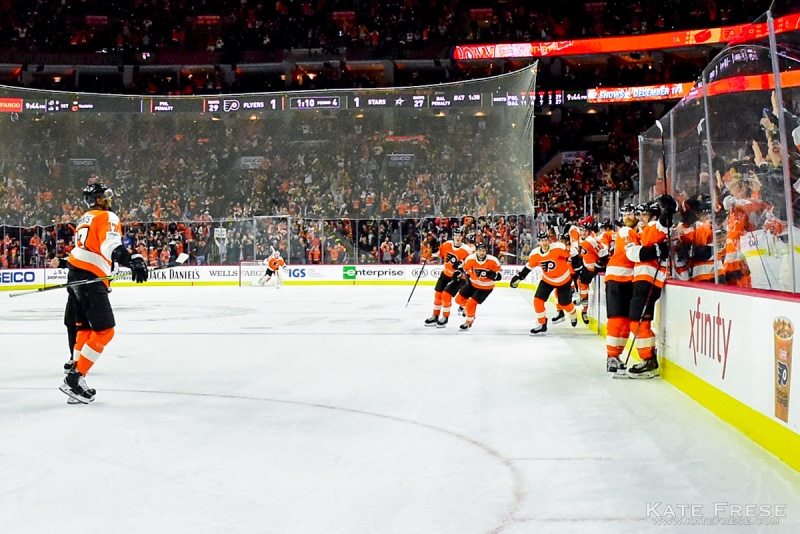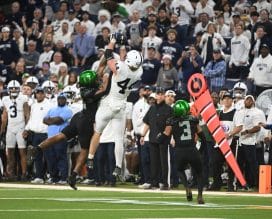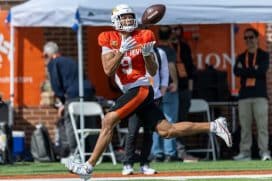Flyers
Flyers-Stars: Postgame Review
(Kate Frese/SB Nation)
By Kevin Durso, Sports Talk Philly editor
It’s been quite the turnaround for the Flyers, who went from losing 10 straight games to now six straight wins, adding to their streak with a 2-1 overtime win over the Dallas Stars on Saturday.
The win keeps the Flyers rolling and really took everything they had and a few opportunistic chances to get it done.
Let’s jump right in with our Postgame Review.
Postgame Points
-
- A Ghostly Game-Winner – This was shades of Shayne Gostisbehere‘s rookie season.There was a game in Ghost’s rookie year in March of 2015 where the Flyers did everything but score on Andrei Vasilevskiy and the Tampa Bay Lightning. Gostisbehere was the budding rookie that had won over the fan base. He scored the tying goal that night in similar fashion to his first goal on Saturday, right on the doorstep with a loose puck in front of him.But in Gostisbehere’s rookie year, it was also about overtime play. And Ghost was everywhere in OT and good at it. He did score a lot on the power play, not exactly like he did on Saturday, but he was always the center of attention in the extra session it seemed. That happened again and now Gostisbehere has six goals on the season.After a phenomenal 17 in his rookie season, he had just seven last season. He’s at six in 32 games for the team, and he’s only played in 29 after missing three with an upper-body injury earlier in the year. This has been a good bounce back year for Ghost as much as anyone else and he was back in the middle of it all on Saturday.
- Power Play – When the Flyers faced the Stars last season in Philadelphia, they were on a seven-game winning streak and trailed by one in the late stages of the third. They got a power play that allowed them to tie the game. They got one shortly after that and scored the game-winner.The Flyers took three first-period penalties in this game and then were clean for the rest of the night. The Stars had one in the second that led to the Flyers goal in regulation, two in the third and one in overtime. It came back to haunt them again…literally I suppose.
- Transition – One thing I really liked in the Flyers game was their transition speed. Dallas had played a hefty schedule of Metropolitan Division opponents in the nights leading up to this game, including a loss in New Jersey on Friday night, but didn’t look worse for wear in this game with their skating.They were certainly dangerous at times, especially Tyler Seguin, who did everything but score in this game, including catching iron on a shot in overtime.But the Flyers really put on a clinic in the second period. Puck protection was good. The passing was on point. They were skating even faster than the Stars were. They were generating chances. It was quite honestly a shock that they only managed one goal at all during that time.But to see the Flyers play up to those standards is very encouraging. It took a lot to get the 2-1 win against Buffalo on Thursday too, but this was a team that was not satisfied with their play. They can certainly be pleased with this effort.
- Fourth Line Buzzing Again – In speaking of a strong skating effort, the Flyers fourth line led by Scott Laughton really provided a ton of energy.The scoresheet won’t show much for this group in limited time, but they were as good as any line the Flyers had on the ice. That kind of tenacity in the offensive zone as to focus on driving the play with energy and not allowed an easy shift for the opposition can be critical to games, and they way that Laughton, Taylor Leier and Travis Konecny played showed every bit of that.Konecny led that grouping with over 14 minutes of ice time — some in OT — but everyone on that line deserves credit for a very strong game that kept the balance over four lines throughout.
- Rough Stuff – It didn’t take long for the Flyers and Stars to start trying to get under each other’s skin. Last year, it was Antoine Roussel trying to be a pest and ultimately getting the desired reaction out of Wayne Simmonds when the game was out of reach for Dallas. This year, Roussel was in on it. Alexander Radulov was around some of it. Dan Hamhuis played the pest role as well.But beyond that, this was a physical game with a lot of good, hard checking and aggression. It’s hard for the atmosphere of a mid-December game to be playoff like, but the action on the ice had that kind of feel to an extent.If the Flyers looked at Thursday’s win as one of those games you have to grind out and find a way, this was one where you really start to empty the tank to try to out-skate, out-hit and out-chance the opponent. Check, check and check.
Quotable
“Our mindset is a lot better right now. I think we take care of pucks. We make the simple play, the right play and it is kind of working for us right now. We have to keep building on that.” – Flyers forward Claude Giroux
Play of the Game
This one obviously goes to Shayne Gostisbehere’s game-winning goal, but there’s so much more that happens on the play. Wayne Simmonds nearly scored moments earlier as his attempt to bat a rebound out of the air went over the net. As the Flyers recovered, Ben Bishop starts jostling with Simmonds. The Stars netminder is without a stick and appears to try to rip Simmonds’ away from him before trying to focus on the puck. It’s too late by then as Gostisbehere’s shot goes right through the wickets and in.
By the Numbers
The Flyers spent a lot of time on the power play in this game, so when you factor that out, this was a very even contest. The Stars got the only goal at 5-on-5 and finished the game with the slight edge in shot attempts at 5-on-5 at 40-39. But in overall shot attempts, which include the Flyers power plays, that was where the Flyers pulled away. With a second period CF% of 61.29, the Flyers finished the game with a 53.91 CF% overall, winning the shot attempts battle, 62-53.
But take a look at the heat map in all situations. The Flyers definitely have put a focus on net-front presence and that has helped turn things around, but they also took a lot of shots from the top of the left circle, like Gostisbehere’s game-winner, and the top of the point. These were typically screened shots or quick one-timers and left Bishop going back and forth across the crease all game.






